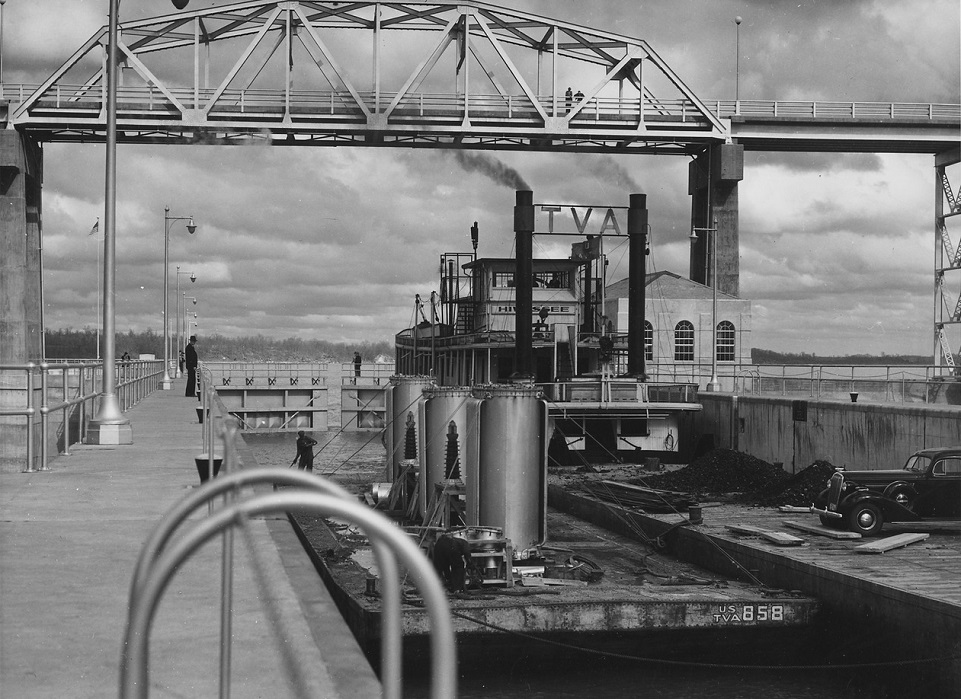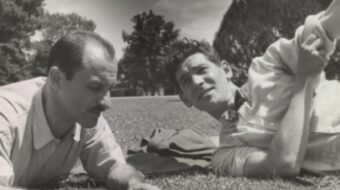
Alan Shulman (1915-2002) was an American composer, cellist and arranger. A quick glance at Shulman’s Wikipedia entry reveals a dedicated composer with a number of prestigious premieres by leading ensembles. He wrote for full orchestra, string orchestra and quartet, piano solo and documentary film. His vocal output was limited to two short compositions. Perhaps for that reason I, as something of a student of American music, had never heard of him before now. A generous, though clearly not a truly representative sampling of his orchestral music can now be appreciated on The Tattooed Stranger: Historic Soundtrack Recordings (1946-1950), a new Bridge CD dedicated to four important documentary film scores from the late 1940s and early ’50s, plus a less than a minute-and-a-half snippet from a fifth. The recordings have been transferred and remastered from the composer’s original acetates.
Judging from their quality (at the same time grasping the limitations of a film score and the recording techniques of the period), it would be interesting to hear more of his music. Shulman receives but a single mention in The Rest Is Noise, Alex Ross’s magisterial study of 20th-century music in a paragraph discussing the role of musical offerings on radio: “The middlebrow ideal was to be sophisticated without being pretentious, worldly but not effete, and classical music with an American accent fit the bill.” That’s a fair evaluation of the music we hear on the CD.
Warner Archive has released on DVD the 1950 RKO police procedural The Tattooed Stranger with Shulman’s score. Shot on location in New York City, this 64-minute whodunit has never been available in any format. Other titles can also be found on various platforms. More news of available recordings by Shulman as performer, arranger and/or composer can be found on the Alan Shulman website, which also lists recent performances of Shulman works. It might be accurate to call him an “almost” forgotten composer.

The Tattooed Stranger score is the longest on the CD, clocking in at 23:57—let’s call it 24 minutes—meaning that a good 40 minutes of the film had no scoring at all. One can assume with some of the other scores, too, that what we hear as a continuous composition is actually a “suite” or compilation, uninterrupted, of the many recorded takes from the longer film. In the case of Stranger, for example, the program notes by Jay Shulman, the composer’s son, indicate that it had 22 “cues.” It’s amazing—to me, anyway—that despite the fact that these musical cues would have been separated in the film by unaccompanied dialogue, they manage to hang together as a “concert” piece as well as they do. The score is, by turns, noir and urban, industrial and nerve-jangling, eerie and skittish, its rich orchestration ripe with Prokofiev influences.
Tennessee Valley Authority, an RKO Pathé documentary from 1946, celebrates one of the great accomplishments of the New Deal—which, of course, would also attract conservative and right-wing critics calling it “creeping socialism” (Pres. Eisenhower), “big government” (Ronald Reagan), and others demanding it be sold off to the private sector.
The film, in the words of Jay Shulman, “depicted the beneficial effects for farmers of the flood control dams constructed in the rural South. Seven rivers flowing through seven states often brought devastation to crops and homes in the region. The dams, many built quickly after Pearl Harbor, helped save agricultural lands while providing power for aluminum and fertilizer factories, employing rural blacks and stimulating the local economy. In Decatur, Alabama, the shipyard was rebuilt. Newly created recreational lakes stimulated tourism. 1000 new homes were constructed and powered by cheap electricity, as was the Oak Ridge nuclear facility. Tree farming, dairy, and meatpacking helped and economy once solely dependent on cotton. DDT, the ‘wonder of war,’ was sprayed on crops and people alike. Alan’s jazzy propulsive brass motif depicts the film’s utopian vision of a modern project ‘Built for the People.’”
The score, second-longest on the disc at 17:50, advances with almost military bravado like an ode to “progress on the march,” with melodic riffs nodding to tropes of the Old South and swelling climaxes so telling of “movie music.”
Shulman had seen wartime service (November 1942 to October 1945) as a professional musician, arranging for the Sheepshead Bay Training Station in Brooklyn and performing in the Maritime Service Orchestra. Shortly after his discharge he was invited to score an 11-minute film called Freedom and Famine (1946), which treated the dire situation of children in post-war Europe. One of the first events depicted is the devastation in Holland caused by the retreating Nazis blowing up the life-saving dykes. Economic recovery is slow, with agricultural production at a virtual standstill, new clothing a rarity (except on the streets of fashionable Paris), fuel rationing, nothing for sale in the markets, and all the psychological effects on children such conditions of poverty might create. The score times out at 10:31, suggesting that Shulman’s music accompanies virtually throughout.
The fanfare of victory quickly dissolves into an earnest church chorale, the score suffused with empathy and an optimistic ending. It was the last of 140 shorts commissioned by the War Activities Committee, made by the President’s Famine Committee and the U.S. Department of Agriculture. Post-war relief for (Western) Europe was one of the hallmarks of anti-communist U.S. foreign policy as, for at least a couple of decades, the Americans strode the world stage as the country that best survived the cataclysm.

The last substantial film score on the CD is another RKO Pathé documentary from 1946, Port of New York, number 9 in a This Is America series, whose score runs 15:35. This film, produced by president of RKO-Pathé News Frederic Ullman, Jr., and directed by Larry O’Reilly, is perhaps the most lyrical and arty of all on this disc, a kind of cinematic poem to a great city and its geographical and economic role in the nation.
It was later reedited and rereleased as The Big Port. Again in Jay Shulman’s program note, it “opens with shots of the harbor. Stevedores unload cargo of tires, hemp and fish. Immigrants, human cargo, also arrive. Ships anchor at Sandy Hook and are boarded by customs agents looking for narcotics. Smugglers’ techniques, including false-bottomed trunks and shoes, are shown. A fanfare announces disease quarantine. Fumigating rats with cyanide gas is depicted by a march. A piccolo accompanies the Coast Guard checking for water pollution. The great harbor’s channels and shoals must be dredged, and driftwood and sand bars cleared. Repairs to ships are made in dry-docks as the port converts from war to peacetime. Twelve railroads converge on New York. The Port Authority maintains tow trucks to control the 9000-foot Holland Tunnel’s traffic. Ventilators remove carbon monoxide. The Port Authority maintains four bridges…. Painting the George Washington Bridge takes four years. No doubt the powerful Robert Moses saw Port of New York as an opportunity to promote his Port Authority of New York and New Jersey.”
The focus of Shulman’s musical commentary is human labor on and around the water, the music echoing the lyricism on the screen, huffing and puffing along with workers on land and sea. In that respect this can be seen as one of America’s great proletarian scores, joining the long line of musical salutes to America’s greatest city.
The CD concludes with a jazzy 1:21 excerpt from a 25-minute “institutional film” about how NBC broadcasts are created, called Behind Your Radio Dial. The original acetate studio recordings may no longer exist. This short sample comes from a 2016 restoration by film critic and historian Matías Mombal.
Considering the source material, The Tattooed Stranger is brilliantly engineered to bring out the best possible quality. These short subjects were a vital part of the cultural ethos of the country, created at a moment before the explosion of entertainment on the new medium of television. The themes of these films were timely, and Alan Shulman was engaged enough in the concerns of his own day to participate in their creation. Apropos of this observation, his son Jay details for us exactly when the recording sessions were held, and what his father was paid for his work, mentioning that at a certain point, later on, he declined jobs because the pay was inadequate.
Listening to old documentary movie soundtracks may not be to every music lover’s taste, but these are lovingly re-created tributes to the skill of a most competent professional musician the rest of whose oeuvre is largely still waiting discovery. Having said which, I see there are some other CDs out—also on Bridge Records, nos. 9137, 9188 and 9397—that feature his cello playing with the Stuyvesant Quartet, and one of his own music (Bridge 9119) I’ll have to check out sometime.
Alan Shulman
The Tattooed Stranger
Bridge 9560
70 minutes, $14.99
We hope you appreciated this article. At People’s World, we believe news and information should be free and accessible to all, but we need your help. Our journalism is free of corporate influence and paywalls because we are totally reader-supported. Only you, our readers and supporters, make this possible. If you enjoy reading People’s World and the stories we bring you, please support our work by donating or becoming a monthly sustainer today. Thank you!










